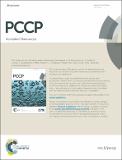Palladium–catalysed alkyne alkoxycarbonylation with P,N chelating ligands revisited : a density functional theory study
Abstract
A revised in situ base mechanism of alkyne alkoxycarbonylation via a Pd catalyst with hemilabile P,N-ligands (PyPPh2, Py = 2-pyridyl) has been fully characterised at the B3PW91-D3/PCM level of density functional theory. Key intermediates on this route are acryloyl (η3-propen-1-oyl) complexes that readily undergo methanolysis. With two hemilabile P,N-ligands and one of them protonated, the overall computed barrier is 24.5 kcal mol-1, which decreases to 20.3 kcal mol-1 upon protonation of the second P,N-ligand. This new mechanism is consistent with all of the experimental data relating to substituent effects on relative reaction rates and branched/linear selectivities, including new results on the methoxycarbonylation of phenylacetylene using (4-NMe2Py)PPh2 and (6-Cl-Py)PPh2 ligand. This ligand is found to decrease catalytic activity over PyPPh2, thus invalidating a formerly characterised in situ base mechanism.
Citation
Ahmad , S , Lockett , A , Shuttleworth , T , Miles-Hobbs , A , Pringle , P & Buehl , M 2019 , ' Palladium–catalysed alkyne alkoxycarbonylation with P,N chelating ligands revisited : a density functional theory study ' , Physical Chemistry Chemical Physics , vol. 21 , no. 16 , pp. 8543-8552 . https://doi.org/10.1039/C9CP01471C
Publication
Physical Chemistry Chemical Physics
Status
Peer reviewed
ISSN
1463-9076Type
Journal article
Description
Authors thank EaStCHEM and the School of Chemistry for support. The Bristol Chemical Synthesis Centre for Doctoral Training (BCS CDT) funded by the Engineering and Physical Sciences Research Council (EPSRC) (EP/G036764/1) and the University of Bristol are thanked for a PhD studentship (to T. A. S.).Collections
Items in the St Andrews Research Repository are protected by copyright, with all rights reserved, unless otherwise indicated.

